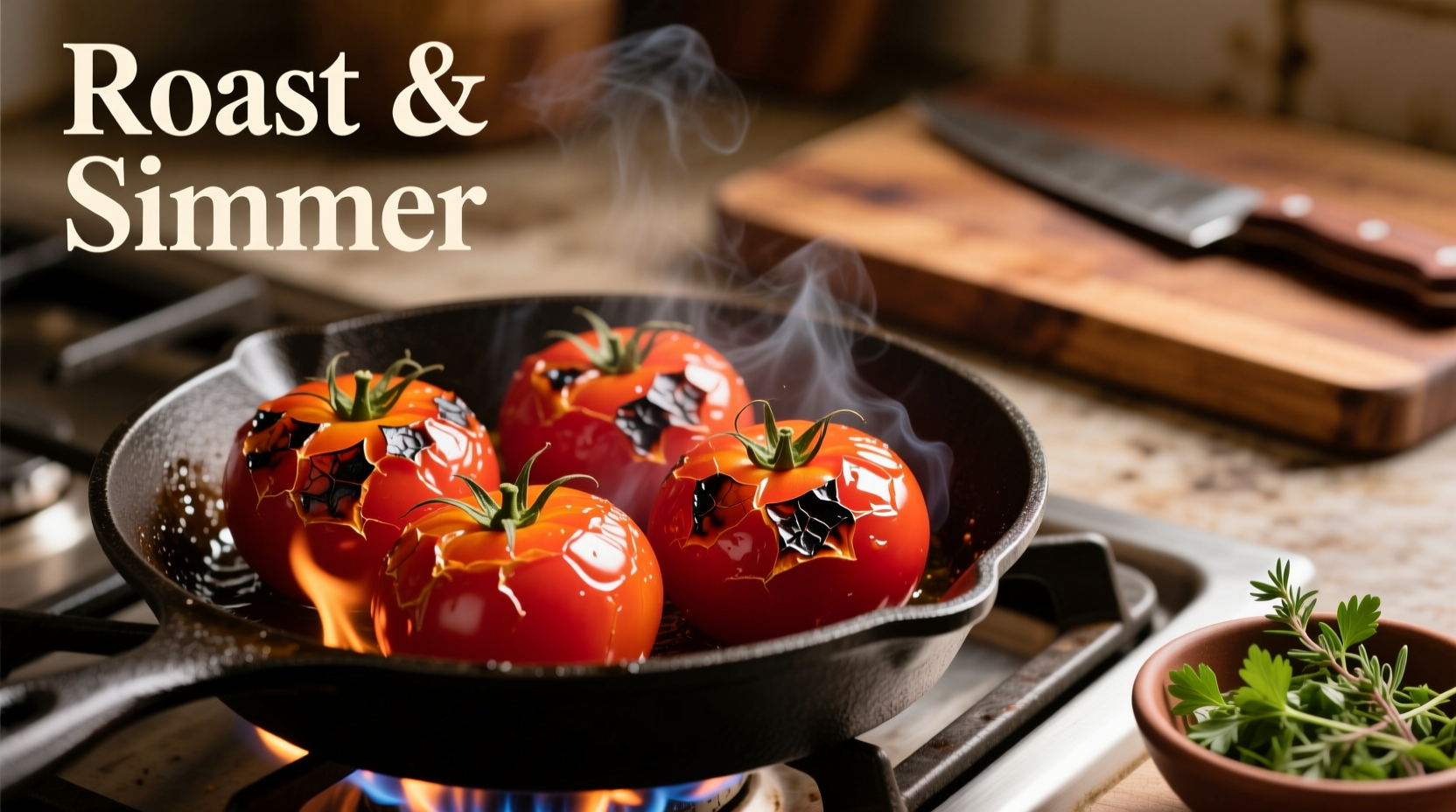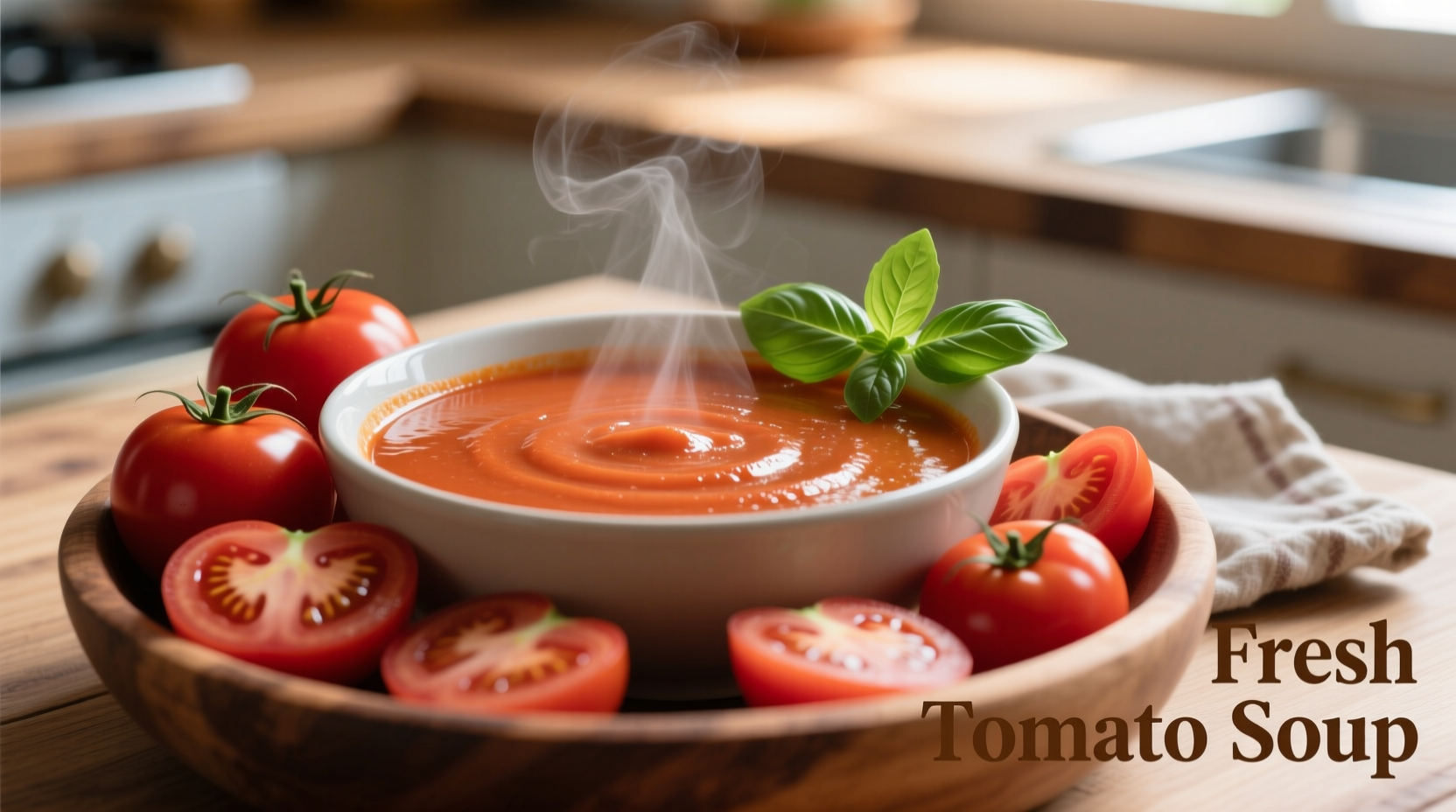Why Fresh Tomatoes Outperform Canned in Soup
When crafting exceptional tomato soup, fresh tomatoes offer distinct advantages over canned varieties. The key difference lies in flavor complexity and texture control. Fresh tomatoes contain higher levels of volatile aromatic compounds that create that unmistakable "just-picked" fragrance, while canned tomatoes undergo thermal processing that alters their chemical composition.
According to research from the USDA's Agricultural Research Service, fresh tomatoes contain approximately 30% more lycopene in their raw state compared to canned varieties. However, the magic happens during cooking—when properly prepared, fresh tomatoes develop richer flavor compounds through controlled caramelization that canned tomatoes can't replicate due to their pre-cooked state.
| Tomato Characteristic | Fresh Tomatoes | Canned Tomatoes |
|---|---|---|
| Acidity Level | Naturally balanced, adjustable during cooking | Fixed acidity from canning process |
| Sugar Content | Varies by ripeness, allows flavor customization | Consistent but often includes added sugar |
| Texture Control | Complete control over pulp consistency | Pre-determined texture from processing |
| Flavor Development | Builds complex layers during cooking | Limited flavor evolution potential |
Selecting the Perfect Tomatoes for Soup
Not all tomatoes work equally well for soup. The ideal varieties balance acidity, sweetness, and flesh density. Here's what to look for when choosing fresh tomatoes specifically for soup:
- Roma (Plum) Tomatoes: The professional chef's choice with thick flesh, fewer seeds, and concentrated flavor. Their lower water content creates naturally thicker soup without needing excessive reduction.
- San Marzano: These elongated tomatoes offer exceptional sweetness with balanced acidity. Grown in volcanic soil in Italy's Sarno River valley, they develop complex flavor compounds that translate beautifully to soup.
- Beefsteak Tomatoes: Best for summer soups when perfectly ripe. Their high water content requires longer simmering but delivers remarkable freshness when in season.
According to the University of California's Agriculture and Natural Resources department, tomatoes reach peak flavor when allowed to ripen fully on the vine. Look for fruits with deep, uniform color and slight give when gently squeezed. Avoid refrigerating tomatoes before use, as temperatures below 55°F (13°C) degrade flavor compounds.

Preparation Techniques That Make the Difference
Proper preparation separates exceptional fresh tomato soup from ordinary versions. Follow these professional techniques:
Peeling Methods: Blanching vs. Roasting
While many recipes call for blanching tomatoes to remove skins, roasting offers superior flavor development. Place halved tomatoes on a baking sheet, drizzle with olive oil, and roast at 400°F (200°C) for 25-30 minutes. The skins will separate easily while the tomatoes caramelize, creating complex flavor compounds that blanching can't achieve.
Managing Seeds and Gel
The gel surrounding tomato seeds contains significant flavor compounds but can create unwanted texture in smooth soups. For the best results:
- Cut tomatoes in half horizontally across the equator
- Gently squeeze over a bowl to collect seeds and gel
- Simmer the collected gel separately for 10 minutes to concentrate its flavor
- Strain and add back to your soup for enhanced depth without texture issues
The Ultimate Fresh Tomato Soup Recipe
This chef-developed recipe maximizes the potential of fresh tomatoes while maintaining perfect balance. Yields 4 servings.
Ingredients
- 2.5 lbs (1.1 kg) ripe Roma tomatoes, cored and halved
- 1 large yellow onion, finely diced
- 3 garlic cloves, minced
- 2 tbsp extra-virgin olive oil
- 1 cup vegetable broth (low sodium)
- 1 tbsp fresh thyme leaves
- 1 tsp sugar (optional, balances acidity)
- Sea salt and freshly ground black pepper to taste
- 2 tbsp heavy cream or coconut milk (for finishing)
Step-by-Step Instructions
- Roast the tomatoes: Preheat oven to 400°F (200°C). Arrange tomatoes cut-side up on a baking sheet. Drizzle with 1 tbsp olive oil and season with salt and pepper. Roast for 25-30 minutes until softened and slightly caramelized.
- Build flavor foundation: While tomatoes roast, heat remaining olive oil in a large pot over medium heat. Add onions and cook until translucent (8-10 minutes). Add garlic and thyme, cooking for 1 minute until fragrant.
- Combine and simmer: Add roasted tomatoes (including juices) and vegetable broth to the pot. Bring to a gentle simmer and cook uncovered for 20 minutes, allowing flavors to meld.
- Blend to perfection: Using an immersion blender, puree the soup until smooth. For ultra-smooth texture, pass through a fine-mesh sieve.
- Final seasoning: Return to low heat. Add sugar if needed to balance acidity. Season with salt and pepper. Stir in cream just before serving.
Flavor Enhancement Secrets
Professional chefs use these techniques to elevate fresh tomato soup beyond basic recipes:
- Acid balancing: Add a splash of sherry vinegar or fresh lemon juice at the end of cooking to brighten flavors without making the soup taste sour.
- Umami boosters: A small piece of Parmesan rind simmered in the soup adds depth without overpowering the fresh tomato flavor.
- Texture contrast: Reserve a few diced tomatoes to add in the last 5 minutes of cooking for pleasant texture variation.
- Temperature control: Never boil tomato soup vigorously after blending, as this breaks down pectin and creates separation.
According to the FDA's food safety guidelines, properly stored fresh tomato soup maintains quality for 3-4 days in the refrigerator. For longer storage, freeze in airtight containers with 1-inch headspace for expansion. The National Center for Home Food Preservation recommends adding lemon juice (1 tbsp per pint) when canning tomato soup to ensure proper acidity for safe preservation.
Troubleshooting Common Fresh Tomato Soup Issues
Even experienced cooks encounter challenges with fresh tomato soup. Here's how to fix them:
- Soup is too watery: Simmer uncovered to reduce, or add a small amount of tomato paste (1-2 tbsp) to thicken without diluting flavor.
- Lacks depth of flavor: Roast tomatoes at higher temperature (425°F/220°C) for more caramelization, or add a small amount of fish sauce (½ tsp) for umami without fishy flavor.
- Color fades during storage: This natural oxidation can be minimized by adding a squeeze of lemon juice before storing, which helps preserve the vibrant red color.
- Acidity imbalance: If soup tastes too acidic, add a pinch of baking soda (⅛ tsp at a time) rather than more sugar, which maintains flavor integrity better.
Frequently Asked Questions
Can I make fresh tomato soup when tomatoes aren't in season?
Yes, but you'll need to adjust your technique. During off-season, select vine-ripened greenhouse tomatoes and enhance flavor with roasted red peppers or a small amount of high-quality tomato paste to compensate for lower natural sugar content. The University of Massachusetts Extension recommends adding ¼ cup roasted red peppers per pound of tomatoes for off-season soup.
How do I prevent my fresh tomato soup from separating?
Separation occurs when pectin breaks down from overcooking. To prevent this, avoid boiling after blending, maintain gentle simmering temperatures below 180°F (82°C), and include the tomato's natural pectin-rich gel by simmering and straining the seed gel as described in the preparation section.
What's the best way to freeze fresh tomato soup?
Cool soup completely before freezing. Portion into airtight containers with 1-inch headspace for expansion. For best results, omit dairy components before freezing and add cream or butter when reheating. Properly frozen fresh tomato soup maintains quality for 6 months according to USDA food preservation guidelines.
Why does my fresh tomato soup taste different from canned tomato soup?
Fresh tomato soup has brighter, more complex flavors with natural sweetness that varies by season and variety. Canned tomatoes undergo thermal processing that creates different flavor compounds and often contains added calcium chloride to maintain firmness, which affects texture. Fresh tomato soup showcases the nuanced flavors of the specific tomato variety used.











 浙公网安备
33010002000092号
浙公网安备
33010002000092号 浙B2-20120091-4
浙B2-20120091-4